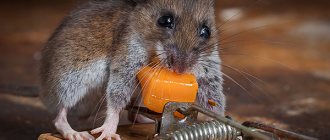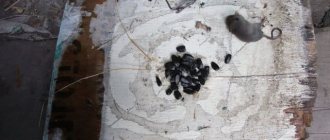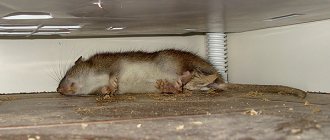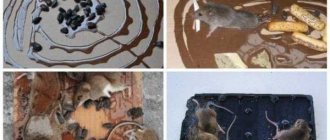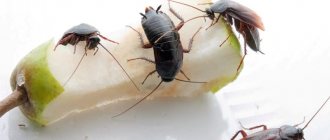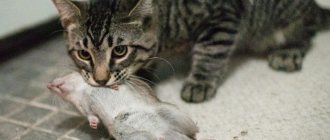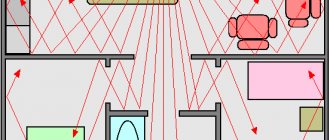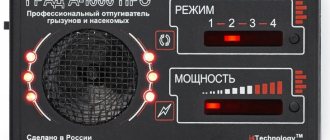Almost always, when the fight against rodents begins, the question arises of choosing an effective bait for rats (and mice as well). This can be either a special poisoned bait that the pest must eat, or simply a certain food product that rats love and which is placed in the trap to effectively attract rodents.
And practice shows that the more attractive the bait is to rats, the sooner they can be poisoned or caught. The animal's desire to eat must be stronger than the fear of an unusual design or suspicion of a new food product.
Accordingly, the question arises of what rats love most. At the same time, thanks to cartoons, there is a widespread misconception that rats and mice love cheese most of all, but in reality this is just a myth - yes, they will eat it, but they may not climb into a trap for it.
Ground meat? Milk? It’s already warmer, but these products are not at all the most favorite delicacy of rodents.
The task is further complicated by the fact that populations of rodents living in different conditions (in a private house, in a sewer, in a garden plot or in a garbage dump) may have their own food preferences. However, through the practice and experience of many rodent control agents, the best baits for rats have been found, which almost always work effectively. We will talk about them in more detail later...
What do rats and mice like?
Both professional rodent exterminators who kill rodents almost every day and biologists who study these animals are well aware that rats mainly love animal products, while mice prefer plant foods . Moreover, this is not a strict rule, but rather a general characteristic of food preferences: for example, mice are also often not averse to eating a piece of lard or meat, and rats, with all their love for meat food, will not refuse grain, and when hungry, even a piece apple
On a note
It is not without reason that many enterprises use poisoned barley to fight rats - not the best bait, but more or less effective, especially when rodents have no other food available.
With that said, some good rat bait options include the following:
- Salo;
- Sausage;
- Ground meat;
- Egg;
- Fish;
- Cheese.
As for mice, bait for them can be as follows:
- A piece of apple or pear;
- A piece of peach or apricot;
- A piece of plum;
- Fresh bread (preferably moistened with sunflower oil);
- Porridge (boiled).
It often happens that certain baits literally hypnotize rats, but mice remain absolutely indifferent to them. Therefore, when deciding what to put in a trap, you need to clearly understand who exactly you plan to lure into this trap: a rat or a mouse.
On a note
A common situation: the owner of the apartment finds nibbled bread or cereal spilled from a bag, but does not know for sure whether it is a rat or a mouse. And a trap with a piece of apple for a mouse can stand untouched for several days, disappointing the owner of the premises, while a little rat lives quietly in the house, indifferent to this bait.
Conclusion: if you are not sure whether rats or mice are in charge of the house, then it is advisable to test different types of bait, choosing products of both plant and animal origin (or put both types of bait in the trap at the same time).
This nuance is also important: not every bait is convenient to put in a trap, just as it is not advisable to mix every rat treat with poison. Therefore, some baits are suitable for one method of fighting, and others are suitable for another.
Let's see what makes sense to use and in what cases.
Conclusion
The fight against rodents due to their large numbers is a long process. During it, the following methods and devices are used:
- Traps - mechanical traps, electric containers, live traps, nets.
- Baits are prepared from flour, grains, seeds, lard, sausage, and eggs. Products are placed in traps in their pure form, or mixed with poison and placed along the passages of animals.
- To prevent mice from getting used to the bait, it is changed every three days.
- Food used as bait must be fresh. Pests will not be attracted to spoiled food.
Bait is important when catching rodents. It helps to lure animals into traps and clear the house of parasites.
Attracting rats to traps
Often one of the main requirements for baits used in rat traps is a dense consistency. The fact is that in many traps you need to place a treat on a hook - the animal will pull it and release the corresponding mechanism. It is clear that minced meat or egg yolk are not suitable for such cases.
The second requirement is a strong smell. The rat, even being far from the trap, must inevitably want to try the treat and be ready to overcome its caution and fear.
The following rat baits have worked well in this regard:
- Smoked sausage;
- Cold smoked fish;
- Lard (ideally with the edge singed over the fire);
- Cheese (preferably smoked);
- A crust of bread, sprinkled with vegetable oil (preferably unrefined, strong-smelling).
The photo below shows an example of a mousetrap in which a rat was caught on a piece of sausage:
However, there are also traps that are triggered by the weight of the animal. They do not require the rat to pull the bait; it is only important to attract the pest and force it to climb inside the trap. In these cases, you can use not only the baits listed above, but also, for example, the following:
- Raw minced meat (preferably with onions);
- Roasted seeds or nuts;
- Chocolate.
It is also useful to read: How to reliably get rid of rats and mice in your private home
If some bait does not attract rats or mice for more than three or four days (especially when the trap itself is set every night in a new place), then such bait must be replaced. In addition, even a well-functioning bait is useful to replace with a fresh one every day or two - its smell gradually weakens and it attracts rats less well.
This is especially important for tunnel traps (and other partially enclosed structures) - the aroma of the treat must be strong enough to escape from the trap and spread throughout the room, which happens more slowly than, for example, from open mousetraps.
Another important point that many rodent fighters do not take into account: at any stage of working with bait, it is highly recommended not to touch it with bare hands, otherwise the human smell will repel rodents.
Rodenticidal foam
You may be interested in: Pests of indoor flowers: types, photos, methods of control and prevention, advice from experienced gardeners
Rodent poison foam is contained in a pressurized container. When leaving it, it acquires a dense mass that does not lose its shape for a long time. This new type of bait has a double effect. It itself is poisonous, and when used, it fills all the cracks where rodents live. Having smeared themselves in it, the rats eat the toxic substance when cleaning their skins.
The poison is convenient because it can be used to coat pipes and walls, and when used, a person does not come into contact with it. The foam is applied directly into holes or onto substrates. It retains its shape for a long time and is readily eaten by rodents. Which bait is best to purchase largely depends on the place of application and the choice of the buyer.
Baits for preparing poison for rats
In order to prepare an effective poison for rats at home (for example, based on Zookoumarin or Krysid), it is advisable to use baits in which the poison can be easily homogenized with the food base.
For example, the following bait bases are good for both rats and mice in this regard:
- Beer, oddly enough, is what rats and mice often cannot resist;
- Milk;
- Meat broth soup;
- Again, raw minced meat, preferably with lard and onions;
- Finely chopped boiled egg;
- Dough with seasonings and spices;
- Boiled porridge, especially with vegetable oil.
Poison is simply added to the food base in the proportions indicated for each drug in the instructions, and the entire mixture is thoroughly mixed. After this, the finished poisoned bait is laid out on a cardboard or saucer (in the case of liquid agents, poured into a plate) and placed where the rats are most likely to quickly find it. All work is carried out wearing rubber gloves.
It is important to take measures to ensure that pets and children cannot reach such bait. This will be discussed in more detail below.
On a note
The vast majority of industrially produced rat poisons are made from dough. Its beauty lies in the fact that the bait turns out to be quite dense, but at the same time not hard, does not fall apart and does not leave marks. In addition, dough briquettes can be easily placed almost anywhere and are much more convenient than bowls of soup or milk.
Take, for example, such products as Mortorat, Rat Death No. 1 and No. 2, Absolon, Ratobor, etc. - these are flavored dough briquettes with blood anticoagulants as the active substance (anticoagulants are one of the most effective rat poisons today). Such a briquette can be placed even in the most inaccessible places, where a saucer with liquid bait will definitely not fit.
However, at home, instead of dough, it is often preferable to use minced meat, which rats love more and which, due to its own strong odor, does not require the addition of flavorings.
A strong smell is also needed to mask the aroma of poison in the bait. Rats are very suspicious and have a very keen sense of smell. If they suspect the presence of a dangerous impurity in a treat (or a human smell), then they will never touch it. Therefore, the stronger the smell of the food base, the greater the likelihood that the rat will be poisoned.
Humane methods of control using homemade traps
Various, sometimes unnecessary items are suitable for making such devices, and vegetable oil, seeds or cheese are suitable as bait. As a result of such efforts, the rodents remain alive; all that remains is to take them out and release them somewhere away from housing so that they cannot return.
Nowadays, getting a plastic bottle of any capacity is not difficult, all that remains is to do the following manipulations with it:
- To make a trap, a plastic bottle with a capacity of 1.5-2 liters, the top part with the neck of which is cut off, is more suitable.
- A container without a neck, from the bottom to the top from the inside, is generously lubricated with vegetable oil, preferably unrefined.
- In addition, a layer of the same oil, about 2 cm thick, is poured onto the bottom and a layer of seeds is poured.
- A trap equipped in this way is installed in a place where mice “like” to host. A special “ladder” made of wood should be attached to the bottle so that mice can climb it to the top point.
- The bottle can be installed either at an angle or straight. The main thing is that the mouse cannot escape from the trap.
- The container must be fixed in a stationary position.
- The trap is set in the evening, and in the morning, if there is a mouse in it, the latter must be taken and released, somewhere on the street or in the yard.
Mousetrap using improvised means
Preparation method:
To do this, you need to take a jar with a capacity of about 1 liter, a small piece of cheese, narrow tape and a coin. First you need to secure a piece of cheese with tape to the bottom of the jar. It is necessary to ensure that the cheese, if you turn the jar over, does not reach the base of the surface by about 5 cm. The trap is installed next to a mouse hole or in another place. To do this, the bank is turned over and placed on an incline using a coin.
Installing the trap requires some care, since the design is minimally stable.
MOUSETRAP from a JAR or HOW TO CATCH ALL THE MICE
Thanks to the achievements of modern science and technology, it has been possible to develop devices that generate ultrasonic waves. Humans do not perceive ultrasound, but most animals perceive these waves, so their behavior may depend on the action of such waves. As you know, there are ultrasonic whistles for giving commands to dogs.
Nowadays, it is not difficult to choose a product, depending on the specific conditions of use, as well as depending on financial capabilities. Moreover, there is no need to catch mice, since they themselves will go in search of more comfortable conditions for their livelihoods.
To solve this issue, just go to a store that sells ultrasonic rodent repellers. As a rule, these are not expensive and compact devices. All that remains is to decide which device to purchase.
To do this, it is better to pay attention to the following factors:
- A good device has the function of adjusting the frequency of the output signal. The fact is that over time, rodents begin to get used to one signal frequency. Some models are capable of changing the ultrasound frequency automatically after a certain period of time.
- For better efficiency, it is better to purchase several devices in order to cover the problem areas of the apartment as much as possible. The fact is that ultrasound does not spread if there is an obstacle in its path, in the form of upholstered furniture or thick curtains.
- Be sure to read the instructions to understand how versatile the device is and whether it can work in conditions of temperature fluctuations. This is necessary so that the device can be used in outbuildings that are not heated.
- If you buy, then a high-quality, universal device, which naturally costs more than some cheap device of dubious origin.
- Where an ultrasonic repeller is installed, it makes no sense to install additional traps, especially with bait that will attract rodents.
- The device should only be used under the conditions described in the instructions, which can guarantee its trouble-free operation.
The following products can be offered for use against mice:
- Typhoon.
- Range.
- Hail.
- Sonar.
- Electric cat.
- Tornado.
- Pest Reject.
Ultrasonic rodent repeller // How does it work? // Review and anti-test drive) Life in the village
Recipes for preparing poison for rats with different baits and poisons
Generally speaking, recipes for poisoned baits for killing rats and mice can be very diverse; it is only important to adhere to the rules noted above when choosing a food base and observe the proportions indicated in the instructions for using the corresponding poison (so that the rat does not notice the danger).
Here are several ready-made recipes that have been tested many times in practice and in most cases give good results when fighting rats:
- 100 grams of minced meat (no matter meat or fish), 850 grams of crushed bread and 50 grams of Zookoumarin;
- 870 grams of crushed bread, 100 grams of onions fried in vegetable oil, and 30 grams of Ratindan;
- 890 grams of crushed bread, 100 grams of vegetable oil and 100 grams of Rat;
- 700 grams of crushed bread, 150 grams of mashed potatoes, 50 grams of vegetable oil and 30 grams of Ratindane;
- 990 grams of cool wheat or oatmeal porridge and 10 grams of Rat.
For these recipes, poisons are taken in the form of powders (dusts) - they are sold in hardware stores.
The ingredients of all recipes are simply mixed thoroughly and placed in portions of about a teaspoon in places where rats can easily find them.
On a note
There are also known folk recipes for poison for rats based on milk and alabaster, as well as those containing an infusion of chilibukha, an emetic nut, as an active ingredient. However, they are significantly less effective compared to poisons based on blood anticoagulants (which include Zookoumarin) and Krysida.
In addition, it should be borne in mind that today there are many ready-to-use poisoned baits for rodents on sale: in the form of dough briquettes, solid granules, poisoned grain, etc. It is often easier (and safer) to buy ready-made preparations than to make poisoned baits on one's own.
It is also useful to read: How to catch a rat in the house: the most effective ways
Powdered poisons
Below you can see several good recipes with powdered poisons that will help you quickly catch rats:
- Boil a kilogram of oatmeal or wheat cereal until smooth, add 10 g. Rat. Mix;
- Mix 100-150 g of minced meat (fish or meat, it doesn’t matter), 800 g of finely chopped bread and 50 g of Zookoumarin into a homogeneous mass;
- Mix 900 g of finely chopped bread, 150 g of vegetable or butter and 10 g of Rat into a homogeneous mass;
- Mix 650 g of finely chopped bread, 100 g of mashed potatoes, 60 g of vegetable or butter and 20 g of Ratindane;
- Mix 100 g of chopped onion, pre-fried in oil, 900 g of finely chopped bread and 40 g of Ratindan.
Of course, like everything in this world, poison baits have their drawbacks, but even with them, these are the best baits you can come up with for catching rats at home.
Mouse specifics
Generally speaking, mice, unlike rats, love cereals, cereals, fruits and vegetables more than animal products. However, one of the most reliable baits in a mousetrap is rightfully considered a piece of lard, slightly fried with a match on one side.
In addition to lard, the mouse trap can be charged:
- A crust of bread soaked in vegetable oil;
- A piece of apple or pear;
- Walnut kernel;
- A piece of smoked sausage (which also attracts rats).
In general, mice are less suspicious of baits than rats.
On a note
As for cheeses, of which there is a great variety on sale, here the opinions of rodent fighters differ. Some consider the use of cheese to catch mice to be completely ineffective, while others, on the contrary, claim that certain brands of odorous cheese catch mice in mousetraps quite well.
Be that as it may, cheese is hardly the product that mice or rats love most.
In mousetraps in which the bait is not attached to the guard, in addition to all of the above products, you can also put fried seeds, fried peanuts, rye crackers and oatmeal cookies.
Porridge, mashed potatoes and dough, all with the addition of vegetable oil, are good food bases for mouse poisoning. These mouse baits are the most versatile and easy to prepare. The same Zookoumarin, Krysid and Ratindan can be used as poison.
Ways to control rodents
The simplest method of controlling rodents is poison. But mice and rats can eat it and die somewhere under the floor. The animal itself will not be in the world, but its stench will haunt the owners of the house for a very long time. Therefore, it is best to catch the animal in a rat trap or any other method. The cat has long been considered a talisman in the house. She always protected the home from rats and mice. Cats are lazier and more imposing, but among them there are also active exterminators of mice and rats. The best catchers are usually outbred cats. It is they who have retained their natural hunting instincts. If there are mice or rats on the farm, you need to get a suitable cat (Fig. 1) that will catch them.
An effective means are various devices with which you can catch a rat. They are called rat traps. Traditional models consist of a frame and a spring. The rat trap contains bait for rats and mice. These may be foods that rodents love:
- pieces of lard;
- sausage;
- crackers;
- cottage cheese;
- baked goods made from wheat, pea, oatmeal flour;
- wheat and rice porridge;
- mealworms;
- flatbreads;
- bread;
- minced meat;
- smoked fish.
All you have to do is grab the bait and pull it, the mechanism is triggered and the rat trap catches the rodent. Rats or mice caught in it die. You should put the bait with gloves on. This will not leave a human smell and will not scare away the rodent. Oddly enough, cheese is not so effective as a bait for rats.
If the method of killing rodents is not suitable for you, and you want to catch a rodent alive, then you need to use special traps. They are made of plastic, metal or wood. The design of these devices is completely different from each other, but the principle remains the same. Rodents fall into a trap from which they can no longer get out. The design can even be electric (Fig. 2). This device is powered by batteries. When a rat gets inside, a powerful electrical discharge occurs, which leaves no chance of survival. Many devices can be made with your own hands.
What to do to prevent pets from finding the bait
With all the hassle associated with preparing effective baits for rats, we must not forget about the safety of their use. The same minced meat, sausage, milk and even dough are loved not only by rats, but also by cats and dogs. In addition, even a small child can easily find such bait. Pets and children can be injured by trying to retrieve a treat from a spring trap (the simplest example of which is a mousetrap) or poisoned by eating poisoned bait.
To prevent this from happening, baits need to be placed where no one except the rodents themselves can find them (or reach them). Such inaccessible places in the house are, in particular, the spaces under the bedside tables and refrigerator in the kitchen, the interior cavities of bedside tables and cabinets, and shelves in the pantry. Of course, when placing bait here, you need to be sure that there are rats in these areas.
A much more effective and safer approach is to place bait or traps with it in special container houses (also called bait stations).
They are boxes with several entrances through which only a rat or mouse can get inside. Neither a cat, nor a dog, nor, especially, a child will be able to get the bait from there, but the box itself, fragrant with minced meat or vegetable oil, can be placed exactly where rats are most often - even in the center of the kitchen.
Some industrial poisons are already sold with such a house, but more often the houses need to be purchased separately. Such containers cost on average from 300 to 2000 rubles. For example, a rat bait container (manufactured by NKF Rat) in St. Petersburg will cost 300 rubles, and a Bora bait station will cost approximately 1,300 rubles.
You can make such a container yourself from an ordinary cardboard box. At the bottom of two opposite walls of the box you need to cut holes with a diameter of 5-6 cm, then put the bait inside and glue the lid with tape. When checking, the tape peels off and the box opens.
And remember: sometimes rats are especially suspicious of baits. Perhaps standard delicacies will not tempt them, and you will need to catch pests with a bait that will have to be figured out by trial and error - be prepared for this. In any case, remember that rats, like any other living creature, need to eat regularly and are hungry several times a day. This means that attracting them into a trap (or poisoning) is only a matter of time and perseverance.
Interesting video: a cautious rat finally fell into a trap with bait
Prevention
Very often the appearance of rodents has already been provoked. They come into houses from the street, this problem is especially relevant in the fall with the first cold weather. In apartments, these can be places above grocery stores or restaurants. To solve this problem, it is not enough to catch or poison a rat once; you need to take care of prevention:
- Perfect cleanliness. We are talking about small crumbs, garbage, and food leftovers in the sink or on the stove;
- Timely garbage collection. It must always be packed. It is best to take out the bags in the evening, because rodents are nocturnal animals;
- Cereals and other bulk products must be stored in closed containers. It is best to put them in glass or metal jars with durable lids.
Neatness, cleanliness, and attention to every detail helps prevent the appearance of rodents after the rats have been caught or poisoned.
The last factor is repairs. You should definitely try to seal all the holes and cracks through which pets enter the apartment. Modern building materials and techniques make it possible to do this and minimize the risk of such pests.
Where is the best place to place a mousetrap?
There is no clear answer here. In principle, no matter where you put it, rodents will sooner or later come across it and be caught.
Another thing is, if you don’t want to wait for who knows how long, it means that you are interested in specifically those places in the house where mice will wander first.
Well, in this case, you need to pay attention to those places where you most often notice or hear pests
Often, such places include the kitchen area, as well as those drawers and shelves where you store various foods, cereals, and where all this is easily accessible to rodents.
Sometimes it happens that a person does not see the mice themselves in his house, but he hears their rustling sounds at night. In such a situation, we can say that the mouse population in the house is still very small. Therefore, it will be easier for you to get rid of unwanted guests. You just need to act as quickly as possible so that the female does not have time to change the situation in her favor.
How to make glue for mice with your own hands
If it is not possible to buy adhesive mass to fight rodents, you can make it yourself.
To do this you will need several components:
- Glycerin – 4 grams.
- Ethyl alcohol – 30 ml.
- Distilled water – 1 liter.
- Wheat fly – 100 grams.
- Gelatin – 5 grams.
Cooking process:
- Soak the gelatin in water for a day.
- Place the container with prepared water in a water bath.
- Add flour, stir thoroughly.
- Heat until almost boiling. Stir until you get a substance with a consistency reminiscent of thick sour cream.
- Add alcohol, glycerin. Stir until the ingredients dissolve.
Because of this, it is necessary to change the plates with adhesive mass several times a day.
Salo
When asked what mice love most, experts answer lard. Rodents can easily recognize high-calorie foods, which they can fill up quickly and for a long time. Lard is considered the most effective assistant in catching mice. To enhance its attractiveness, the treat is lightly fried with a match to make the smell more captivating. It is necessary to use fresh lard with an attractive aroma; the smell of old and stale lard repels them.
To save money, you can put the skin with the remaining lard in the rat trap. Such bait will not deteriorate for a long time and will retain an appetizing smell for the mouse.
